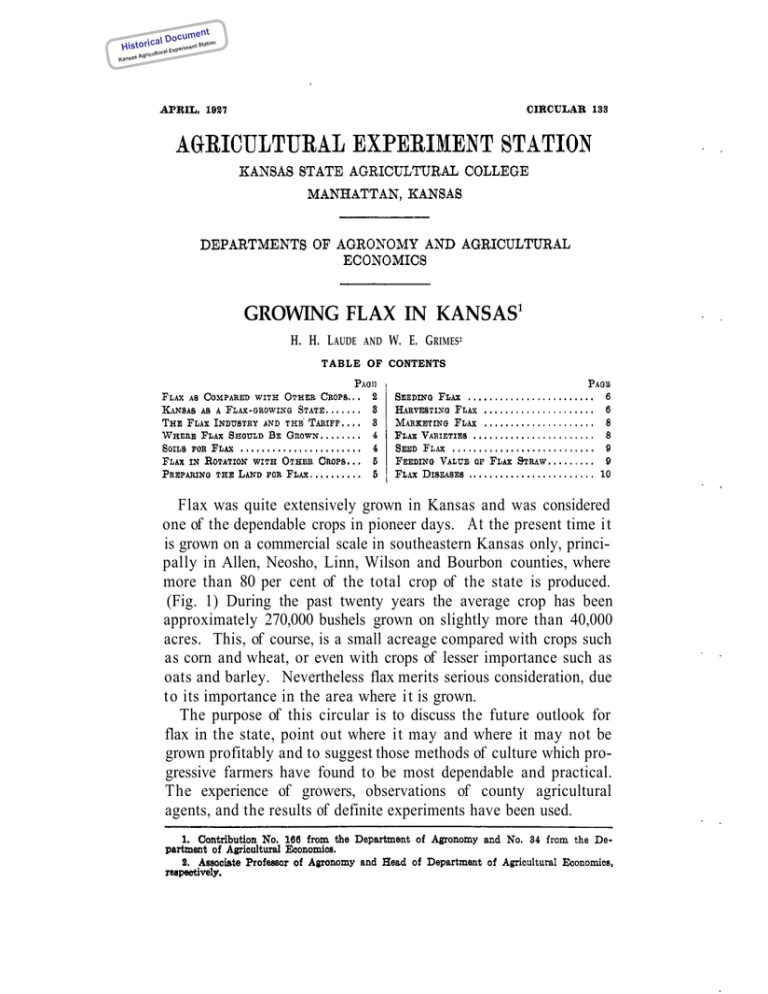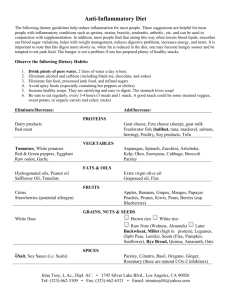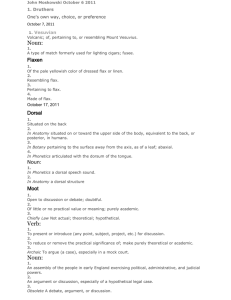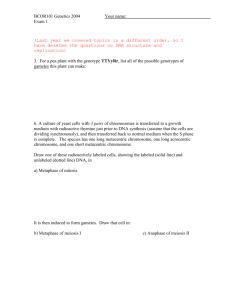GROWING FLAX KANSAS IN
advertisement

Kansas t cumen cal Do Histori n t Statio perimen ral Ex ricultu Ag GROWING FLAX IN KANSAS1 H. H. L AUDE AND W. E. G RIMES² T A B L E OF CONTENTS Flax was quite extensively grown in Kansas and was considered one of the dependable crops in pioneer days. At the present time it is grown on a commercial scale in southeastern Kansas only, principally in Allen, Neosho, Linn, Wilson and Bourbon counties, where more than 80 per cent of the total crop of the state is produced. (Fig. 1) During the past twenty years the average crop has been approximately 270,000 bushels grown on slightly more than 40,000 acres. This, of course, is a small acreage compared with crops such as corn and wheat, or even with crops of lesser importance such as oats and barley. Nevertheless flax merits serious consideration, due to its importance in the area where it is grown. The purpose of this circular is to discuss the future outlook for flax in the state, point out where it may and where it may not be grown profitably and to suggest those methods of culture which progressive farmers have found to be most dependable and practical. The experience of growers, observations of county agricultural agents, and the results of definite experiments have been used. Kansas tural Agricul t cumen cal Do Histori Experim ion ent Stat FLAX AS COMPARED WITH OTHER CROPS I n southeastern Kansas flax occupies much the same position in the cropping system as oats. It can conveniently be grown after corn and therefore fits well into a rotation with corn and wheat. Like oats it is considered a good crop to sow with or preceding a grass or hay crop. It is a better cash crop than oats and because it is sown in the spring, may be considered as supplementing wheat in this respect since wheat is often the most dependable cash crop of this region. The relative yields and value per acre of flax, oats, and wheat for the past ten years in the five leading flax-growing counties in Kansas are shown in Table I. ricul nsas Ag t cumen cal Do Histori perimen tural Ex n t Statio Ka Flax has produced somewhat larger average returns per acre than oats, but considerably less than wheat. The comparison is not entirely a fair one, however, in view of the fact that flax is often grown on the poorer land. The cost of growing flax is less than wheat but slightly more than oats. KANSAS AS A FLAX-GROWING STATE Kansas ranks fifth among the flax-growing states, being exceeded by Minnesota, North Dakota, South Dakota, and Montana. The average yield is of interest since the profit in growing a crop depends materially on the yield. The average yields for the principal flaxgrowing states as given by the United States Department of Agriculture are shown in Table II. The average yields were less for Kansas than for any other state except Montana. The averages for Montana were less than would normally be expected because of unusually dry weather in recent seasons. The figures indicate that flax has been grown under less favorable conditions in Kansas than elsewhere. The low yields are in part due to unfavorable climatic and weather conditions and are partly the result of poor soil and cultural methods that are not always the best for the crop. Considering that in Kansas flax is grown on fully as high-priced land as in Montana, North Dakota, and South Dakota it is apparent that Kansas flax-growers have been a t a disadvantage. THE FLAX INDUSTRY AND THE TARIFF Since 1909 the United States has imported flax-seed to supply a part of the domestic demand. Prior to 1909, considerable quantities were exported but production declined and since then the country has been on an import basis. In 1909 a tariff of 25 cents a bushel was imposed on flax. This was reduced to 20 cents in 1913, raised to 30 cents in 1921 and to t cumen cal Do Histori Kans riment Expe ultural as Agric Station 40 cents in 1922. The more recent tariffs have stimulated production in the important flax-producing states, and the United States. acreage was nearly three times as much in 1924 as in 1921. Flax Prices and the Tariff.-The effect of the tariff may also be seen in comparing flax prices at Minneapolis, Minn., with those at Winnipeg, Canada. From September, 1923, to January, 1926, the price at Minneapolis ranged from 6 to 49 cents a bushel higher than Winnipeg prices. Most of the difference was due to the tariff. So long as flaxseed is imported the tariff will continue to be a t least partially effective in increasing United States prices over world prices. An important effect of a high tariff is to stimulate production in the main flax-growing states. Materially increased production could again place the United States on an export basis with lower prices. WHERE FLAX SHOULD BE GROWN In recent years there has been some agitation in Kansas for the growing of flax outside of the present area, especially in the western part of the state. The experience of many farmers who have tried it and attempts to grow it under experimental conditions show rather clearly that it is not adapted to this region. As an average for two years at the Hays Branch Experiment Station, Hays, Kan., flax produced a yield of 2.4 bushels per acre compared with 35 bushels for oats. At the Federal Field Station a t Akron, Colo., which is near northwestern Kansas, flax produced an average yield of 4.4 bushels compared with 38 bushels for barley. Several attempts by farmers to grow flax in southwestern Kansas resulted in complete failure. Altogether it seems there is little or no reason for growing flax beyond its present area in Kansas. SOILS FOR FLAX Flax may be grown successfully on practically any soil that is suitable for other small grains. The principal limitation is weeds. Flax makes an open growth and does not compete with weeds as well as does oats or wheat. For this reason it seldom produces a profitable crop on foul land. Is Flax Hard on the Land?-It is often believed that flax is hard on the land. This is probably due to the fact that when flax is grown year after year the land becomes infected with flax wilt, a disease which may live in the soil for several years and greatly reduce the yields or even completely destroy succeeding crops of flax. t cumen cal Do Histori Kansas riment ral Expe ricultu Station Ag So far as known, flax has no permanent ill effect on the soil and it need not be feared for that reason. It should, of course, be grown in rotation with other crops. FLAX IN ROTATION WITH OTHER CROPS Flax is most generally sown on land that was in corn the preceding season. Excellent crops are produced on newly broken native sod or tame-grass meadows and pastures. It is sometimes grown after small grains and occasionally after kafir or other sorghums. Sorghum ground is likely to be difficult to get in shape for flax and usually should be planted to other crops. Flax should never be grown on the same land year after year since, as stated above, it is quite likely to become infected with flax wilt under such conditions and be seriously injured or destroyed. PREPARING THE LAND FOR FLAX The best method of preparing land for flax will depend on the previous crop and the condition of the field. Any preparation that secures a finely pulverized surface with a thoroughly packed subsurface is satisfactory. A finely-pulverized smooth surface may crust badly after a hard rain, but it is better to risk this danger rather than to seed in poorly prepared ground. Corn and kafir fields may be disked in preparation for flax if the land is free of trash and the growth of stalks is not too heavy. Double disking deeply in the fall and lightly in the spring usually gives best results. Soils that tend to bake or run together need thorough shallow working in the spring, especially in wet seasons, while light soils need little if any work other than to smooth the surface. If stalk land is not disked in the fall, preparation should start as early as possible in the spring. Except in the case of clean stalk land, plowing is advisable and should be done in the fall or early winter. Spring plowing is usually unsatisfactory because it is difficult to obtain a good seedbed by the time flax should be sown. Plowing in late winter or early spring may be advisable on land that runs together badly or on which winter erosion is serious in fall-plowed fields. Land plowed in the fall has ample time to settle and during the winter the surface becomes mellow and in excellent physical condition so that little work with the disk and harrow is needed in the spring. Fall plowing may be five or six inches deep while later plowing should be shallow; in fact only deep enough to turn the furrow slice t cumen cal Do Histori Kansas riment Expe ultural Station Agric evenly and cover the trash well. Sod land should be plowed no deeper than is necessary to do a good job. SEEDING FLAX Probably not more than half the Kansas flax crop is drilled, the remainder being broadcast by one of several methods. The most common method is to seed with an endgate seeder, covering the seed with a harrow. With the common grain drill it is difficult to accurately control the uniformity in depth of seeding and the feed adjustment cannot always be set to insure uniform or proper rate of seeding. The spacing of the drills seven or eight inches apart is probably too wide for best results with flax. Some of these objections may be avoided by taking the hose out of the tube and letting the seed scatter broadcast either in front of or back of the disks. In either case the land should be harrowed after the seeder the same as though sown broadcast. A grass or alfalfa drill is well suited for seeding flax and where available, is the most satisfactory implement. Experience has shown that shallow seeding is desirable. Drills are ordinarily set to plant as shallow as possible and rarely cover the seed more than one inch. Time and Rate of Seeding.-The usual rate of seeding flax is one-half bushel or 28 pounds per acre. When the seedbed is in excellent condition and a good drill is used the rate is sometimes reduced to as low as 20 pounds while if sown broadcast or in a less favorable seedbed the quantity is increased to as much as 35 pounds per acre. The last week in March or the first week in April is generally considered the best time to sow flax, although many growers prefer earlier seeding if it is possible to work the fields. Some believe that April 10 is soon enough to sow. Occasionally flax is sown in May, although it usually does not produce so well as when seeded earlier. For best development, flax requires cool weather a t the time of blossoming and ample soil moisture until ripening begins. Such conditions are most likely if the seed is sown early. HARVESTING FLAX Flax should be fully ripe when cut. The bolls are then brown, the stems golden and few if any leaves are on the plants. If flax is cut too green i t does not cure readily and the yield of seed is apt to be reduced and of inferior quality. If allowed to become overripe it deteriorates because of exposure and shattering increases. In wet, Kansas tural Agricul t cumen cal Do Histori ion ent Stat Experim cool seasons the crop may not ripen uniformly or the plants may start a second growth. Under such conditions it may be necessary to cut the crop when the largest proportion of the bolls are ripe. The self-rake reaper formerly was used almost exclusively in harvesting flax and is now preferred by many growers. The ordinary grain binder is also extensively used. Flax may be bound or not as preferred. The branched plants cling together and hence twine is not essential. When the grain is not bound the binder parts are sometimes removed and replaced by an attachment that drops the flax in bunches. However, binding the bundles is considered desirable since it permits shocking the grain and thus keeps the bolls off the ground and prevents damage that otherwise might occur. Since flax crops are sometimes practically destroyed by rainy weather after harvest, binding and shocking is the best method for general practice. Flax should be threshed as soon as it is cured. With favorable weather curing will require from three to ten days. If threshing cannot be done promptly the flax should be stacked and the stacks covered with long grass or with a tarpaulin, since flax straw does not turn water well. Threshing from the field is probably best if a threshing machine is available as soon as the crop is cured. Loss in Handling.-Careful handling while harvesting the crop and the use of tight or canvas-covered racks in hauling flax to the thresher or stack will do much to prevent shattering and the loss of shattered seed. It is important to avoid tramping the load, In unloading a t the thresher, canvases should be placed under the feeder and a t other places where the seed may shatter or leak from the machine. Flax may be stacked on a thick layer of fine hay t o prevent shattered seed from sifting to the ground. This hay can be put through the machine to separate the seed. Some growers do not have a man on the stack but arrange the bundles from the wagon. Operation of Thresher.-Flax is usually considered more difficult t o thresh than other grains. However, a good machine correctly adjusted and operated should do satisfactory work with dry, well-matured flax. If either the straw or the bolls are damp much of the grain may go over with the straw. It is important to run the machine at a uniform speed, which requires a reserve of power, and to feed it slowly and evenly. It is usually not advisable to at- t cumen cal Do Histori riment Expe ultural as Agric Station Kans tempt to thoroughly clean the flax with the thresher since this nearly always causes a greater quantity of seed to go over with the straw. The goal of the operator should be to save all of the seed regardless of the trash mixed with it. MARKETING FLAX The bulk of the Kansas flax crop is handled by local dealers and shipped to the Fredonia Linseed Oil Works Company a t Fredonia, Wilson county, Kansas. Occasionally some is shipped to a northern market. Local grain dealers usually buy flax from growers on the basis of clean seed. Flax is usually sacked a t the thresher and in many cases the sacks are furnished by the local dealer. Tight wagon boxes are necessary to hold bulk flaxseed. Most of the flax crop is sold in July and August and much of it is hauled directly from the thresher to the elevator, although a few growers hold their crop and market it a t opportune times throughout the year. Some growers believe the early market is usually the best since the Kansas harvest precedes that of the main flax-growing section in the Northern States. Others prefer to market soon after harvest because of the difficulty in storing flax satisfactorily on the farm. FLAX VARIETIES The variety of flax usually grown in Kansas is known as Southwestern, although many growers term i t local, native, or just “flax.” The name is used to distinguish it from northern-grown seed which when imported into Kansas is known as Northwestern or simply Northern. So far as known, there is no real difference and it is probable that Southwestern flax is nothing more than Northwestern which has been grown in Kansas for one or more years. Several varieties of flax, including some wilt-resistant kinds, have been tested for two years on the Rest Experimental Field in Wilson county.3 The yields of grain for 1924 and 1925 are given in Table III. North Dakota 40013 with an average yield of 8.4 bushels, and L i n o t a with 8.1 bushels to the acre were the two highest yielding varieties each season. These are nearly alike, having been developed from the same source. Red Wing, North Dakota 114, Chippewa and North Dakota 40023 yielded in the order named. The t cumen cal Do Histori Ka riment pe tural Ex Station ricul nsas Ag two local varieties, Southwestern and Northwestern, yielded nearly the same and were exceeded by six of the seven other varieties. Reserve made the lowest yield each year. Winona, which was included the second season, made a fair yield. All varieties except Reserve and North Dakota 40023 are resistant to wilt. They belong to the group known as short-fiber flax. They have slender stems, fewer basal branches, a compact head and generally are somewhat earlier. than the European or Russian seed varieties. The locally grown flax is usually of the short-fiber type but in most cases is not resistant to wilt. It appears quite likely that some of the wilt-resistant varieties mentioned above will eventually prove to be more productive than the flax generally used in southeastern Kansas. However, more extensive tests will be necessary to determine this point. SEED FLAX Flax intended for seeding should be recleaned before storing, and only dry, sound, plump seed should be saved. This will reduce the loss from wilt and other diseases which may be carried as spores on the broken stems chaff, and immature seeds. Flaxseed should be dry when threshed and stored only in a dry place. FEEDING VALUE OF FLAX STRAW Flax must be considered primarily a cash crop since the seed is always marketed and the yield of straw ordinarily is low. Most growers consider the straw of fair value for feed, usually rating it t cumen cal Do Histori Kansas riment ral Expe ricultu Station Ag about equal to oat straw. It seems to be well suited for fattening cattle. The feeding value depends both on the condition of the straw and the quantity of seed it contains. FLAX DISEASES The principal disease of flax in Kansas is wilt. Wilt is a fungus disease that attacks flax plants a t any stage of growth, causing them to wilt and die. It grows on both the live plant and the dead flax roots and stems in the soil. When once introduced into the soil it lives for an indefinite time. Rotation of crops has been found helpful in avoiding damage from wilt. In the northern flax-growing states, wilt is controlled by rotation of crops, the use of wilt-resistant varieties, and by early seeding. It is probable that some wilt-resistant variety will prove to be satisfactory for planting in Kansas.





